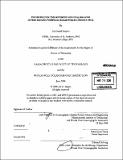Orchestration : the movement and vocal behavior of free-ranging Norwegian killer whales (Orcinus orca)
Author(s)
Shapiro, Ari Daniel
DownloadFull printable version (60.77Mb)
Alternative title
Movement and vocal behavior of free-ranging Norwegian killer whales (Orcinus orca)
Other Contributors
Woods Hole Oceanographic Institution.
Advisor
Peter Lloyd Tyack.
Terms of use
Metadata
Show full item recordAbstract
Studying the social and cultural transmission of behavior among animals helps to identify patterns of interaction and information content flowing between individuals. Killer whales are likely to acquire traits culturally based on their population-specific feeding behaviors and group-distinctive vocal repertoires. I used digital tags to explore the contributions of individual Norwegian killer whales to group carousel feeding and the relationships between vocal and non-vocal activity. Periods of tail slapping to incapacitate herring during feeding were characterized by elevated movement variability, heightened vocal activity and call types containing additional orientation cues. Tail slaps produced by tagged animals were identified using a rapid pitch change and occurred primarily within 20m of the surface. Two simultaneously tagged animals maneuvered similarly when tail slapping within 60s of one another, indicating that the position and composition of the herring ball influenced their behavior. Two types of behavioral sequence preceding the tight circling of carousel feeding were apparent. First, the animals engaged in periods of directional swimming. They were silent in 2 of 3 instances, suggesting they may have located other foraging groups by eavesdropping. Second, tagged animals made broad horizontal loops as they dove in a manner consistent with corralling. All 4 of these occasions were accompanied by vocal activity, indicating that this and tail slapping may benefit from social communication. No significant relationship between the call types and the actual movement measurements was found. Killer whale vocalizations traditionally have been classified into discrete call types. Using human speech processing techniques, I considered that calls are alternatively comprised of shared segments that can be recombined to form the stereotyped and variable repertoire. (cont.) In a classification experiment, the characterization of calls using the whole call, a set of unshared segments, or a set of shared segments yielded equivalent performance. The shared segments required less information to parse the same vocalizations, suggesting a more parsimonious system of representation. This closer examination of the movements and vocalizations of Norwegian killer whales, combined with future work on ontogeny and transmission, will inform our understanding of whether and how culture plays a role in achieving population-specific behaviors in this species.
Description
Thesis (Ph. D.)--Joint Program in Oceanography/Applied Ocean Science and Engineering (Massachusetts Institute of Technology, Dept. of Biology; and the Woods Hole Oceanographic Institution), 2008. Includes bibliographical references.
Date issued
2008Department
Joint Program in Oceanography/Applied Ocean Science and Engineering; Woods Hole Oceanographic Institution; Massachusetts Institute of Technology. Department of BiologyPublisher
Massachusetts Institute of Technology
Keywords
/Woods Hole Oceanographic Institution. Joint Program in Oceanography/Applied Ocean Science and Engineering., Biology., Woods Hole Oceanographic Institution.